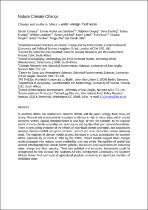JavaScript is disabled for your browser. Some features of this site may not work without it.
- ResearchSpace
- →
- Research Publications/Outputs
- →
- Journal Articles
- →
- View Item
| dc.contributor.author |
Conway, D

|
|
| dc.contributor.author |
Archer, Emma RM

|
|
| dc.contributor.author |
Derynglin, D

|
|
| dc.contributor.author |
Dorling, S

|
|
| dc.contributor.author |
Krueger, T

|
|
| dc.contributor.author |
Landman, W

|
|
| dc.contributor.author |
Lankford, B

|
|
| dc.contributor.author |
Lebek, K

|
|
| dc.contributor.author |
Osborn, T

|
|
| dc.contributor.author |
Ringler, C

|
|
| dc.contributor.author |
Thurlow, J

|
|
| dc.contributor.author |
Zhu, T

|
|
| dc.contributor.author |
Dalin, C

|
|
| dc.date.accessioned | 2016-02-23T08:50:00Z | |
| dc.date.available | 2016-02-23T08:50:00Z | |
| dc.date.issued | 2015-09 | |
| dc.identifier.citation | Conway, D, Archer, ERM, Deryng D, Dorling, S, Krueger, T, Landman, W, Lankford, B, Lebek, K, Osborn, T, Ringler, C, Thurlow, J, Zhu, T and Dalin, C. Climate and southern Africa's water-energy-food nexus. Nature Climate Change, Vol. 5, pp. 837-846 | en_US |
| dc.identifier.issn | 1758-678X | |
| dc.identifier.uri | http://www.nature.com/nclimate/journal/v5/n9/full/nclimate2735.html | |
| dc.identifier.uri | http://hdl.handle.net/10204/8394 | |
| dc.description | Copyright: 2015 Nature Publishing Group. Due to copyright restrictions, the attached PDF file only contains the post-print version of the full text item. For access to the full text item, please consult the publisher's website. The definitive version of the work is published in Nature Climate Change, Vol. 5, pp. 837-846 | en_US |
| dc.description.abstract | In southern Africa, the connections between climate and the water–energy–food nexus are strong. Physical and socioeconomic exposure to climate is high in many areas and in crucial economic sectors. Spatial interdependence is also high, driven, for example, by the regional extent of many climate anomalies and river basins and aquifers that span national boundaries. There is now strong evidence of the effects of individual climate anomalies, but associations between national rainfall and gross domestic product and crop production remain relatively weak. The majority of climate models project decreases in annual precipitation for southern Africa, typically by as much as 20% by the 2080s. Impact models suggest these changes would propagate into reduced water availability and crop yields. Recognition of spatial and sectoral interdependencies should inform policies, institutions and investments for enhancing water, energy and food security. Three key political and economic instruments could be strengthened for this purpose: the Southern African Development Community, the Southern African Power Pool and trade of agricultural products amounting to significant transfers of embedded water. | en_US |
| dc.language.iso | en | en_US |
| dc.publisher | Nature Publishing Group | en_US |
| dc.relation.ispartofseries | Workflow;15560 | |
| dc.subject | Water–energy–food nexus | en_US |
| dc.subject | Climate exposure | en_US |
| dc.subject | Climatic spatial interdependence | en_US |
| dc.subject | Southern African Development Community | en_US |
| dc.subject | Southern African Power Pool | en_US |
| dc.title | Climate and southern Africa's water-energy-food nexus | en_US |
| dc.type | Article | en_US |
| dc.identifier.apacitation | Conway, D., Archer, E. R., Derynglin, D., Dorling, S., Krueger, T., Landman, W., ... Dalin, C. (2015). Climate and southern Africa's water-energy-food nexus. http://hdl.handle.net/10204/8394 | en_ZA |
| dc.identifier.chicagocitation | Conway, D, Emma RM Archer, D Derynglin, S Dorling, T Krueger, W Landman, B Lankford, et al "Climate and southern Africa's water-energy-food nexus." (2015) http://hdl.handle.net/10204/8394 | en_ZA |
| dc.identifier.vancouvercitation | Conway D, Archer ER, Derynglin D, Dorling S, Krueger T, Landman W, et al. Climate and southern Africa's water-energy-food nexus. 2015; http://hdl.handle.net/10204/8394. | en_ZA |
| dc.identifier.ris | TY - Article AU - Conway, D AU - Archer, Emma RM AU - Derynglin, D AU - Dorling, S AU - Krueger, T AU - Landman, W AU - Lankford, B AU - Lebek, K AU - Osborn, T AU - Ringler, C AU - Thurlow, J AU - Zhu, T AU - Dalin, C AB - In southern Africa, the connections between climate and the water–energy–food nexus are strong. Physical and socioeconomic exposure to climate is high in many areas and in crucial economic sectors. Spatial interdependence is also high, driven, for example, by the regional extent of many climate anomalies and river basins and aquifers that span national boundaries. There is now strong evidence of the effects of individual climate anomalies, but associations between national rainfall and gross domestic product and crop production remain relatively weak. The majority of climate models project decreases in annual precipitation for southern Africa, typically by as much as 20% by the 2080s. Impact models suggest these changes would propagate into reduced water availability and crop yields. Recognition of spatial and sectoral interdependencies should inform policies, institutions and investments for enhancing water, energy and food security. Three key political and economic instruments could be strengthened for this purpose: the Southern African Development Community, the Southern African Power Pool and trade of agricultural products amounting to significant transfers of embedded water. DA - 2015-09 DB - ResearchSpace DP - CSIR KW - Water–energy–food nexus KW - Climate exposure KW - Climatic spatial interdependence KW - Southern African Development Community KW - Southern African Power Pool LK - https://researchspace.csir.co.za PY - 2015 SM - 1758-678X T1 - Climate and southern Africa's water-energy-food nexus TI - Climate and southern Africa's water-energy-food nexus UR - http://hdl.handle.net/10204/8394 ER - | en_ZA |






